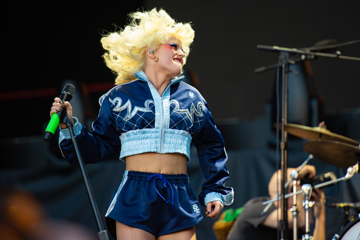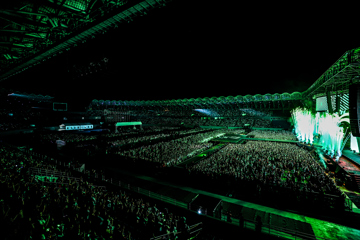SHE GOT GAME: Why It's Past Time To Stop Mistreating Women In Gaming
Though widely considered the sole domain of testicle-possessing nerds, the grid is steadily being infiltrated by girl gamers.
This article was originally published in Three magazine issue 3, October 2011.
The hunter looks the priestess up and down. “I can,” he smirks, “but it will cost you.”
“That won't be a problem,” the priestess says. “I have plenty of gold on my main character. I can mail you some.”
Don't miss a beat with our FREE daily newsletter
“I don't want your gold,” the hunter laughs.
“What do you want?”
The hunter's eyes flash. He smirks and moves closer. “That's simple,” he whispers. “Pics or GTFO.”
 Gaming: it's a great paradox of the 21st century. We live in the most advanced, allegedly enlightened era in history; an age of unprecedented technological marvels, social progress, and economic hubris, and, accordingly, the world of video games has changed radically in our lifetimes. We've seen games come from rudimentary text-based experiments in coding limitations to pixelated kilobyte and megabyte-sized curiosities on floppy disks all the way to the hyper-stylised HD, 3D, motion-sensing licenses to print money they are today. As video games have grown in size and scope both creatively and in their recreational use, so too has developed the image of “the gamer”.
Gaming: it's a great paradox of the 21st century. We live in the most advanced, allegedly enlightened era in history; an age of unprecedented technological marvels, social progress, and economic hubris, and, accordingly, the world of video games has changed radically in our lifetimes. We've seen games come from rudimentary text-based experiments in coding limitations to pixelated kilobyte and megabyte-sized curiosities on floppy disks all the way to the hyper-stylised HD, 3D, motion-sensing licenses to print money they are today. As video games have grown in size and scope both creatively and in their recreational use, so too has developed the image of “the gamer”.
The figures are surprising, given that video game stores don't strike as the place to go “scoping for tail
It is here, however – for all its technological, creative and cultural wonderment – in focusing so heavily on that stereotype that the industry and its critics have, for the most part, failed a large contingent of their supporters; a contingent which, a 2010 study by the US Entertainment Software Association found, now makes up 40% of the general gaming, and 42% of the online gaming, audience: women. In fact, the study found that women aged 18 or over now even make up a larger percentage (33%) of the game-playing population than boys aged 17 or under (22%). The figures are surprising, given that video game stores don't strike as the place to go “scoping for tail”, as the 1980s liked to say.
Indeed, Amy (last name withheld), an employee at one of Australia's largest video game retailers, says that girls are still not overly present in their stores, and even when they are, they're not buying games for themselves, but “for their boyfriends and partners”. Still, she concedes, this does not necessarily indicate girls aren't gaming. “We did have a little talk, a couple of us, about girls and gaming and stuff – there's a greater majority of girls going to games online, because they socialise and meet people online,” Amy says. “There are a lot more girls going online to meet people, as opposed to just gaming, but there are definitely more girls actually playing just to play.” So, much of the evidence points to levels of near-gender equality among the game-playing community, and yet, as the only-slightly fictionalised exchange in Auberdine hints (character classes were changed to protect the innocent), girls still stand out as an anomaly in video game culture; an unwelcome or at least unconsidered demographic in an industry historically driven by men.
THAT'S GOOD OLD FASHIONED SEXISM
There was a time when it was questionable whether or not girls even played video games, much less made up almost half of the gaming population. It's typically been thought of as a male pastime – in the late 20th century among children and adolescents, and now in the early 21st among children, adolescents, and the adults who used to be them. There's no question it has always been a man's virtual world: historically, when women showed up in video games, they were either helpless damsels or objectified in ultra-sexual ways. But video games have moved from niche interest to billion-dollar global industry and their appeal has broadened in kind, and – in fairness – although developers have been slow to react, they are at least reacting.
Sure, “girl gamer” is still a page of its own on Wikipedia for some reason (what other subculture does that? Is a “girl musician” different from a “musician”?), but at least strong female characters (playable and otherwise) are far more regular occurrences than in years past – though maybe that's been part of the problem. With no realistic or relatable characters to engage with, perhaps it's understandable girls previously shied away. Developers' early attempts, while well intentioned, were pretty misguided. Lara Croft, who first appeared in 1996, is an independent woman, to be sure – rich, smart, adventurous – but let's face it, if you played Tomb Raider as an adolescent male, at least 68% of your game time was spent maneuvering the camera for the best shot you could get of Lara's ridiculous chest.
Your game time was spent maneuvering the camera for the best shot you could get of Lara's ridiculous chest
There was even an infamous patch, Nude Raider, developed outside the Eidos/Core studios that made Lara appear naked. Keep in mind, this was 1997 and Lara was a horrifically pixelated creation. Think about what that says about gamers at the time. It's taken 15 years, but it'll only be next year, in new developer Crystal Dynamics' fifth Tomb Raider game – an eponymous reboot of the series – that Lara's breasts will be reduced to a less-distracting size and help step her towards actually being something resembling a more complete image of a credible female protagonist.
Samus Aran, of Metroid fame, is one of the industry's oldest and most-loved female protagonists, having first appeared in 1986 and avoided the trappings of 90s and 2000s sexualisation thanks to her androgynous armour. Joanna Dark, too, of Rare's Perfect Dark, was a success. More recently, Chell from the Portal series is notable for being a non-sexualised protagonist, with the focus being on not what she is, but what she can do. In fact, first- and third-person shooters are surprisingly flush with not only female players, but a willingness on the developers' part to meet their needs. “[Girls mostly purchase] more shooters, always shooters,” Amy says. “We've got a girl that comes in here all the time, she's a massive Gears of War 3 fan. That's all she plays.
 “With, say, Gears of War, they've made a female character because they know females like to play. So they've started that, and now they've started that, hopefully the rest of the developers will take that into consideration – that not all girls will want to play as a male character.”
“With, say, Gears of War, they've made a female character because they know females like to play. So they've started that, and now they've started that, hopefully the rest of the developers will take that into consideration – that not all girls will want to play as a male character.”
One could argue most developers already do consider the fairer sex: many games allow you to choose the gender of your character at the outset, with no handicap placed upon you for picking one over the other. So at least in terms of the industry moving to meet the needs of a changing market, progress is being made – albeit slowly. Even more slowly, however, when the 40% of the gaming audience who we are focusing on is brought into contact with the other 60%. That's when things just get sad.
LESS QQ, MORE PEWPEW
Ladies, if you've gotten this far and started to think, “well, this is all a bit extreme. I'm a girl, I play video games, and I've never been put off by misogynistic developers, exposed to lecherous night elves online nor been treated differently in Halo just because I have boobs”, well, consider yourselves fortunate. Amy says, as a female gamer, she has “absolutely” been exposed to shameless sleazing and abuse because she doesn't have a Y chromosome, though she admits the situation isn't as dire as it has been previously. “Playing online all the time, I do see more and more people respecting that I'm a girl gamer – so they're not chasing after me or anything like that,” she says. “I always play with a whole bunch of guys, so they've always got my back. But yeah, sometimes I've just got to be careful – hide my profile if I can or appear offline.”
Marnie Harris, a dedicated video-games fan since an early age, has had similar experiences, especially given her genre of choice – the aforementioned and apparently totally chick-filled world of first-person-shooters. She regularly plays Team Fortress 2, and has found it has more than its fair share of oiled-up douchebags ready to get lecherous or abusive. “Same with Killing Floor, actually,” she says. “A lot of people are like, 'what? There's a girl playing?' and then they leave. Which is sad, because I'm a really good medic.”
Although players can't choose the gender of their avatars (in-game character representations) in TF2, Harris is not shy about making herself known for who she is.
“I'm a total geek; I really get into voice, like, headset gaming,” she says. “So I tend to be quite vocal in games if people are being arseholes.”
And people are, apparently, arseholes. Even moreso when you put them behind a first-person view of a gun, Harris says. “I would say [it is worse for female FPS players], because most people who are FPS players, I would say, are people who started off playing Counter-Strike, and Counter-Strike when it came out was such a male-oriented game,” she explains. “But I have friends who play World of Warcraft and one of my best friends met her husband on World of Warcraft and he moved from the States for her, so I wouldn't say that it was generally in every single genre.
“If I wanted to be verbally abused by people, I would play COD [Call of Duty] online, but… I don't. They totally seem like they'd all be jocks because it's such an accessible game.”
Now, admittedly, I'm not a woman, but I've been in online guilds with a few and I even met one in real life once, and I can tell you from experience, not even the fantastic world of Azeroth is free from jerks. Some female guildmates chose male avatars to avoid being identified as women in the virtual world. Some male guildmates chose female avatars specifically because of the “special treatment” they would receive from horny, clueless denizens. But this is getting into another whole world, of gender identification in online video games, and is a separate discussion for another time.
Of course, this isn't just limited to online games, at least in the massively multiplayer sense. Take, for example, a recent Battlefield 3 LAN party held in Texas, which had included this in its attendance guidelines: “Nothing ruins a good LAN party like uncomfortable guests or lots of tension, both of which can result from mixing immature, misogynistic male-gamers with female counterparts. Though we've done our best to avoid these situations in years past, we've certainly had our share of problems. As a result, we no longer allow women to attend this event.”
This happened this year, remember. Naturally, people took issue with the exclusion being phrased as such and the statement was summarily removed and replaced with some spin-drivel about the LAN party being a “gentleman's retreat”, as though that makes it any better than being “whites only”. Solve misogyny by banning the women. Flawless victory.
STILL ALIVE
Well, not entirely flawless. You see, as industry and personal recounts have shown, girls like first-person shooters as much as any other genre. Hell, it doesn't even seem like a lot of girls are really all that interested in games that are overtly aimed at appeasing people with ovaries anyway. ““I don't really go for overly girly games,” Harris says. “I don't think any game should be intentionally genderised, but a lot of them are.”
So that leaves an interesting proposition for the industry. Here, you have 40% of an audience, most of whom are as happy to blow people up with rocket launchers as their jock boyfriends are, to whom generally terrible propositions are being offered, aside from the odd Fable or Portal: play grotesque, overly gender-specific games that glorify socially anachronistic activities, like Cooking Mama (Wii, see sidebar); online, they can hide their identities by choosing male avatars or never speaking at all in TeamSpeak or Ventrilo while the rest of their guild or unit or whatever is talking about masturbation and beer; or they can take the brave step of being as open as they want about their gender and, at best, get hit on and/or abused and, at worst, being banned from playing around guys.
Harris feels that there are some measures that the industry could take to remedy the situation at least partially. “I know when TF2 was made free a little while ago, or quite a bit before that, they had a training ground where people could play online with other new players, or do practice rounds and sort of learn how the mechanics of the game work, and learn to strategise a bit better,” she explains. “So that when you go into a game for the first time, it's not like, 'I have no idea what I'm doing. What are these tactics people are using?'”
This doesn't sound like a big deal but – let's face it – guys can be jerks, and especially guys that take their games seriously. I should know; I am one. If we're in a boss fight, and you're not moving out of the goddamn fire novas, then, vagina or not, you're getting yelled at.
Which, really, is the crux of the whole situation. As Amy says: “It's not really up to the developers. They could probably try, but it's more the people that are online.”
So here's the deal: girls are very much a part of gamer culture. While the industry is taking what little steps they can, the main onus on making them feel welcome and equal in the virtual realm is on its male contingent. A lot of guys who play games mistreat the girls they come across and, simply, it's time we cut it out. Not out of some ridiculous sense of male guilt, or pandering or because we think girls are fragile or anything, but simply because they have as much right to play and enjoy games as anyone else, and there's no good reason to go on acting like they're not there.
Sidebar
THE SLOW MARCH OF PROGRESS
BARBIE: GAME GIRL (Game Boy, 1992)
The only redeemable thing to come out of this offensive mess is the base assumption that, somewhere, the developers thought they were doing the right thing. In terms of functionality as a game, Barbie: Game Girl wasn't a complete failure: it was no more or less responsive than most side-scrolling platformers of the day and, if memory serves, Barbie did like three somersaults every time she jumped, which is at least marginally impressive.
Nonetheless, the levels were uninspiring, linear chores that largely took place in shopping malls (which seemed to be filled with shoe stores) as you gathered items to piece together the perfect outfit for Barbie's date with Ken. Really. In defense of my manhood, my sister owned this, okay? Now let's forget our troubles with a big bowl of strawberry ice-cream.
CHARLIE'S ANGELS (PlayStation 2/Nintendo Gamecube, 2003)
This game had promise: tough female protagonists in a 3D-beat 'em up. It seemed a fair attempt at equality in gaming. It wasn't even really overly sexualised or anything, tight leather pants notwithstanding. Oh, except for the introductory sequence at a Beach Beauty pageant where Angels Natalie and Alex, dressed in swimsuits, get ambushed and have to start ruining people's days with punches and bludgeonings.
But even this wasn't the biggest affront: It was a huge failure because it was just a horrific game. There is a better-than-average chance it was programmed by a high-school IT class full of blind children who had never used computers before. Bug-filled, repetitive and seemingly not really actually based on the Charlie's Angels franchise but for the presence of the film's stars, it was an exercise in frustration and hurling controllers at things. Here's a tip, Ubisoft: walls are not supposed to be invisible.
COOKING MAMA (Nintendo DS, 2006; sequels 2008 and 2009; Wii sequels, 2007 and 2008)
As a rule of thumb, games should not be based on domestic chores. Call it a hunch, but Backyard Clean-Up 3D or Washing Dishes with Wario would not exactly top Christmas lists. So the success of this game is bewildering: not only did it win accolades (IGN gave it a "Best of E3" rating), but it spawned four sequels across the DS and Wii platforms. It's almost as if Nintendo decided that, if girls were adamant about playing games, they should be games that make them remember where they belong: in the kitchen. There is no depth to this game beyond following "Mama's" instructions as fast as you can. Chop that tomato! Toss that salad! Peel like your life depends on it! I'd rather dip my penis in hydrochloric acid. Worst of all, if you screw up, Mama gets angry at you and plays the old "don't worry, I'll fix it," card, the guilt-inducing bitch. People at IGN are idiots sometimes.







